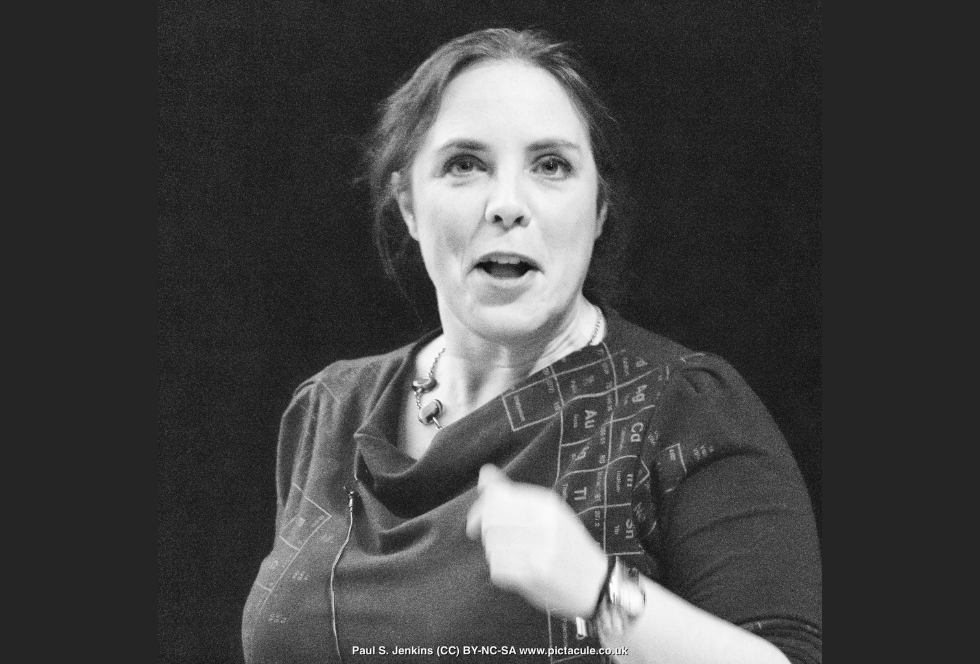The COVID-19 pandemic may have taken talks, meetings and pitch sessions online – something we addressed in our previous blog posts with tips to make your Zoom go with a boom. But as vaccination rates continue to rise and cases (hopefully!) start to fall, we can start to look forward to presenting in front of a real live audience rather than a webcam.
While some people are natural born performers – like our Creative Director Dr Kat Arney – many of us in the scientific world find public speaking daunting.
Whether it’s giving a compelling conference talk, inspiring public audiences, or presenting the perfect investor pitch, we’re sharing some of our top tips to help you tell your story with confidence.
Start with your story
We’ve already covered how to tell a compelling story in our previous posts Boom! Shake the Zoom and Why Every Startup Needs a Story but it’s worth reiterating here.
Every great talk starts with thinking about who you’re speaking to, what they need to know, and what you want them to do when they’ve finished listening.
Next it’s a case of constructing a story that makes sense, with a clear beginning and end, and a meaty chunk of action in the middle.
Not only will having a strong structure make it easier for your audience to follow your story, especially if you’re presenting new or complex ideas, but it’ll also make it much easier for you to tell.
Look into my eyes…
It’s easy to feel detached from your audience in this new online era. The best you can hope for is a rogues’ gallery of fuzzy faces or black boxes on mute, while delivering a conference or large webinar presentation can seem like you’re just talking to yourself.
A real audience is full of real people, who are looking to engage with you and your ideas.
Help to create a human connection by looking to people in different parts of the room and making eye contact with them for a few seconds before moving on. It feels a bit awkward at first but it’s a trick that can make every member of the audience leave the room feeling like they’ve been personally spoken to.
If you’re on a big stage with dazzling lights and can’t actually see your audience, the same technique still works. In your mind, divide the audience up into four quadrants and move your gaze slowly between them every couple of sentences, so you appear as if you’re connecting with everyone.
Take it slow
Almost everyone speaks too fast when they’re starting out as a public speaker, especially when we’re feeling nervous. While this is helpful for keeping events running to time, it can make it hard for people to follow along and digest everything you’re saying.
Firstly, remembering to breathe and pause between sentences not only helps with nerves but also slows your pace, giving the audience a chance to catch up.
Another foolproof way to avoid sounding and feeling rushed is to properly plan and script your presentation in advance, so you know how long you expect to take. A good public speaking speed is around 150 words per minute, plus a bit of extra time for changing slides and pauses.
Then, when you’re practising your talk, make sure you’re running through it in ‘presentation mode’: speak out loud at a slow, clear pace, rather than skimming through in your normal conversational voice or under your breath.
Another handy tip is to film or record yourself speaking the same part of your talk at different speeds starting with your regular conversational voice then getting slower and slower, then playing it back to a trusted friend.
You’ll be surprised to discover that speaking at what feels like a snail’s pace actually comes across as powerful and authoritative, while your regular speaking voice might sound nervous and rushed.
Use your space
If you can, step away from the lectern or laptop and bring your presentation to life by using your space as part of your story.
Wandering aimlessly around the stage can be distracting, but purposefully using your environment can be a subtle but incredibly powerful way of engaging your audience.
Moving from one area to another can be used to transmit the idea of moving in geographical space, such as moving between cities or taking a voyage.
Remember that your view is opposite to your audience, so if you’re describing moving from London to Bristol or New York to San Francisco you’ll need to move from left to right so the journey makes sense to them.
You can also use movement to denote the passing of time. For example, stand on the left of the stage when you’re talking about something that happened in the past, then move across to the right as you bring the action to the present or even into the future.
Alternatively, you can move to distinct spaces to denote specific events or groups of people as you talk about them.
As you plan your talk, create a physical map of the stage area in your mind or on a piece of paper. Allocate locations to different parts of your presentation and practice moving between them as you talk so it feels and looks natural.
Steady your stance
You may not realise you’re doing it until someone points it out, but some people have a habit of leaning to one side or even standing on one leg as they speak (as Kat knows from personal experience!)
It may not seem important, but your lack of stability creates a feeling of unease and uncertainty in your audience, which is the opposite of what you want when you’re trying to build confidence and belief.
The good news is that you don’t have to adopt the infamous Tory ‘power stance’ to be taken seriously.
Unless you’re deliberately moving on stage, focus on keeping your feet both planted squarely under your hips, brace your core and pull your shoulders back to exude confidence in the right way.
Raise your hands
Your hands are always accessible props that can help to enhance your story, adding interest and emphasis where they’re needed.
Quartz has a ‘handy’ rundown of some common (if a little cheesy) hand gestures beloved of TED speakers, but you can always try out other movements that work uniquely for your story such as tracing out the shapes and sizes.
Move slowly and deliberately, so you don’t feel like you’re just flapping your hands about or wrestling an invisible weasel.
Practice in front of a mirror or film yourself with your phone to see what’s working and what’s not. If you’re in search of inspiration, here’s a great video about how to use your hands well during presentations.
All killer, no filler
Getting rid of those filler words like ummm, errrr and OK will give your public speaking a professional edge. Knowing your material and practising it obviously helps you give a polished performance, but many of us habitually use filler words without even realising we’re doing it.
Start by listening to recordings of yourself speaking and identify your filler word(s) or other vocal tics (and yes, you’ll probably hate the sound of your own voice…)
Fillers usually slip into natural breaks in sentences or in between them. One method to remove them is to try and train yourself to deliberately pause silently at the end of each phrase as you reach for the next, rather than letting a noise fill the space instead. It’s a tricky task but it’s certainly achievable with practice.
This article in Forbes has some more tips to get rid of your fillers, or check out Kate Cocker’s brilliant video about how to banish umms for good.
Practice makes for perfect public speaking
As with everything else in life, practice makes perfect. Don’t forget to practice your gestures and stage movements at the same time as practising the words, so it all gets into your brain together and flows seamlessly when the time comes to deliver it for real.
Get help!
When asked what would help them engage more with the public, scientists give communication training as one of their top responses. But only 1 in every 4 researchers has been trained in science communication.
At First Create The Media, we love helping people in the life sciences unlock their power as compelling storytellers and speakers for pitches, TED talks, public events and more.
Get in touch to find out how we can help you bring your ideas to life for the audiences that matter to you.
Photo: Dr Kat Arney speaking at Winchester Skeptics, Paul S Jenkins CC BY-NC-SA via Flickr

